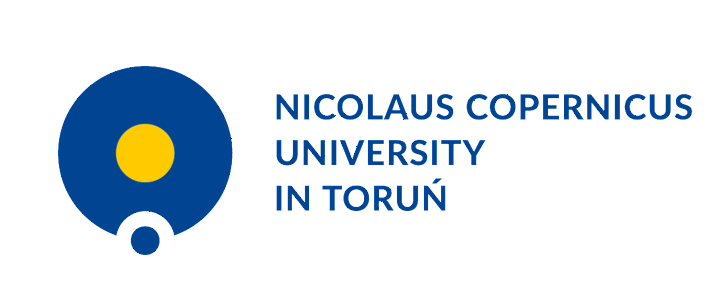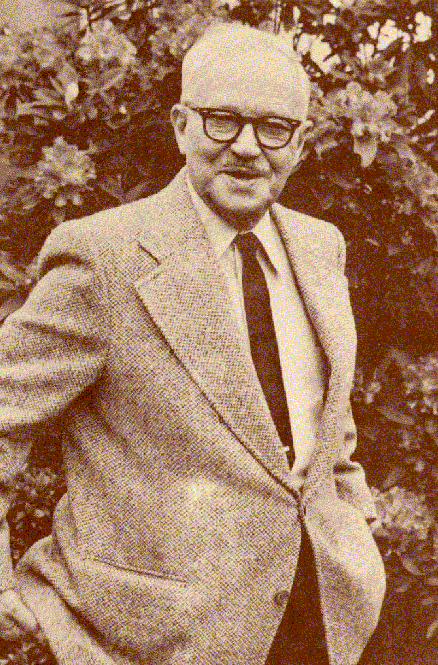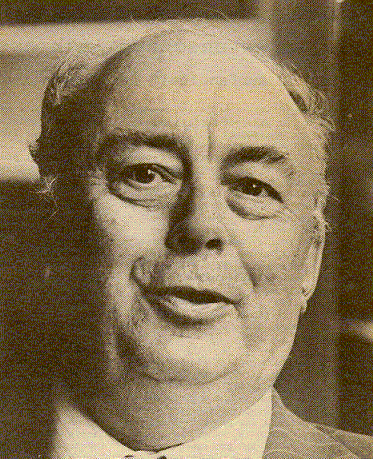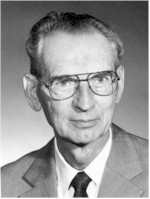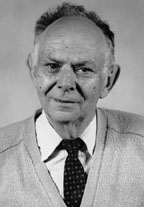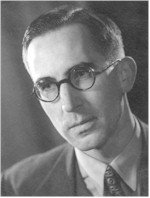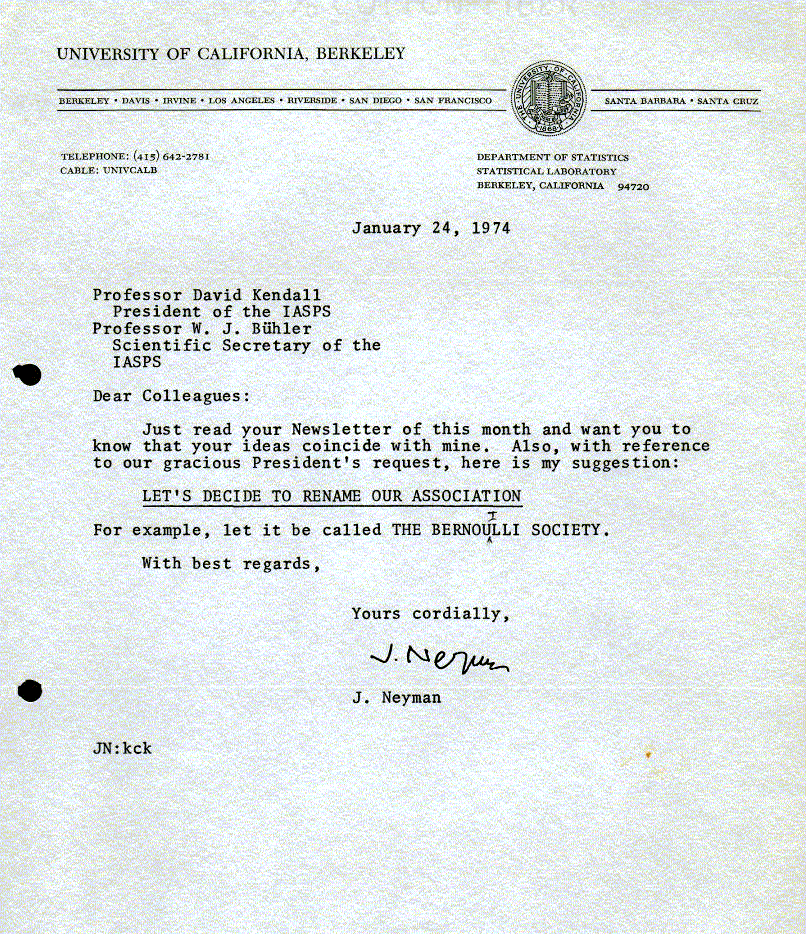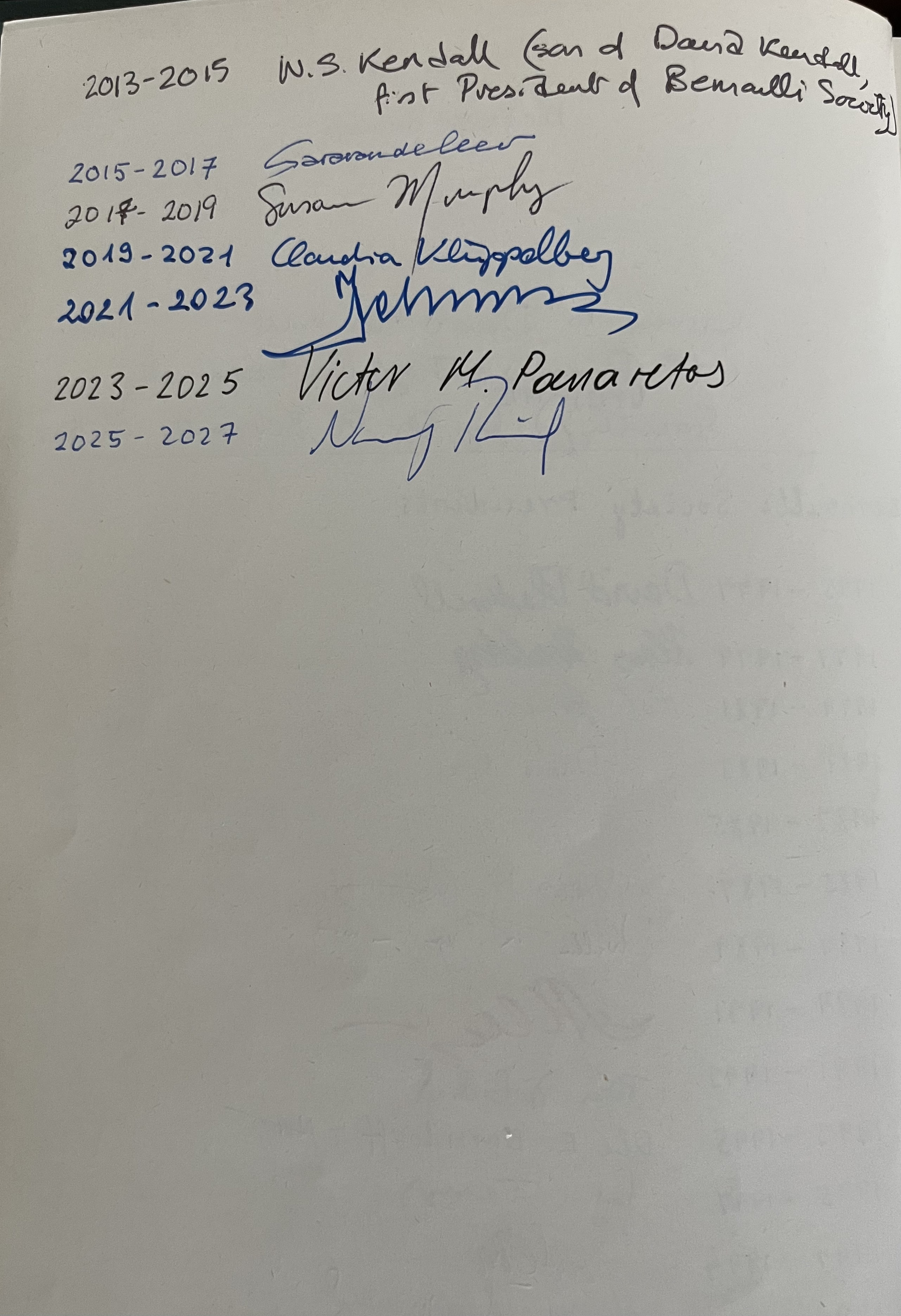

|
|
Features
Prizes
Invited Lectures
DisclaimerContentThe Bernoulli Society reserves the right not to be responsible for the topicality, correctness, completeness or quality of the information provided. Liability claims regarding damage caused by the use of any information provided, including any kind of information which is incomplete or incorrect,will therefore be rejected. All offers are not-binding and without obligation. Parts of the pages or the complete publication including all offers and information might be extended, changed or partly or completely deleted by the department without separate announcement. Referrals and linksThe Bernoulli Society is not responsible for any contents linked or referred to from his pages - unless it has full knowledge of illegal contents and would be able to prevent the visitors of its site from viewing those pages. If any damage occurs by the use of information presented there, only the author of the respective pages might be liable, not the one who has linked to these pages. Furthermore the Bernoulli Society is not liable for any postings or messages published by users of discussion boards, guestbooks or mailinglists provided on his page. CopyrightThe Bernoulli Society intended not to use any copyrighted material for the publication or, if not possible, to indicate the copyright of the respective object. The copyright for any material created by the Bernoulli Society is reserved. Any duplication or use of objects such as diagrams, sounds or texts in other electronic or printed publications is not permitted without the department's agreement. Privacy policyIf the opportunity for the input of personal or business data (email addresses, name, addresses) is given, the input of these data takes place voluntarily. The use and payment of all offered services are permitted - if and so far technically possible and reasonable - without specification of any personal data or under specification of anonymized data or an alias. The use of published postal addresses, telefone or fax numbers and email addresses for marketing purposes is prohibited, offenders sending unwanted spam messages will be punished. Legal validity of this disclaimerIf sections or individual terms of this statement are not legal or correct, the content or validity of the other parts remain uninfluenced by this fact. Contact InfoThe Bernoulli Society is an Association of the International Statistical Institute: ISI Permanent Office The backend aministrator is Adrian Figiel (This email address is being protected from spambots. You need JavaScript enabled to view it.). New Researchers Award 2026 – Winners Announcement We are pleased to announce the recipients of the 2026 New Researchers Award in Probability Theory: Awardees:
Honorable Mentions:
Congratulations to all for their outstanding contributions to the field! The Bernoulli Society for Mathematical Statistics and Probability was created in years 1973-75 and since 1975 it has been a member of the International Statistical Institute (ISI) family. The Bernoulli Society is an international organization whose objectives are the advancement of the sciences of probability (including stochastic processes) and mathematical statistics and of their applications to all those aspects of human endeavour, which are directed towards the increase of natural knowledge and the welfare of mankind. The activities of the Bernoulli Society include:
See Presentation of the Bernoulli Society for a review of these activities. The Bernoulli Society offers reduced membership for PhD students, new members and members from low and middle income countries and regions. Joint BS-IMS and ISI-BS-IMS memberships are also possible at a reduced rate. For the latest news see our News & Calls, Bernoulli News, eBriefs. Since 2022 a secretariat of the Bernoulli Society has been functioning at the Nicolaus Copernicus University in Torun, Poland. Please send any inquires to This email address is being protected from spambots. You need JavaScript enabled to view it.
Content 0. The Bernoulli Society World CongressesThe details of the World congresses are listed separately. 1. The first 25 years of the Bernoulli SocietyThe Bernoulli Society has been officially created on 10 June 1975 at Voorburg in the Netherlands. Past-President Louis Chen mentioned in one of the recent issues of Bernoulli News that the collective history of the Bernoulli Society is diminishing quickly and that something should be done to recover and sustain it. I therefore gladly accepted the challenge to dive into the archives hoping to refresh the latent memory of the society. I'm very grateful to the Programme Committee of the Fifth World Congress for instigating me to cover some of the highlights of the past 25 years and before. Three rather independent groups have been involved before the conception of the Bernoulli Society. There was first the International Association for Statistics in the Physical Sciences, IASPS for short. This society was linked to the International Statistical Institute and should be viewed as the main predecessor of our current Bernoulli Society. Then there was a link with the Institute of Mathematical Statistics through its former European Regional Committee. Finally, from a totally different and independent direction came the Committee for Conferences on Stochastic Processes. In what follows, I will sketch the role that has been played by each one of these three groups. In a nutshell, on 10 June 1975 IASPS legally adopted the two other committees as daughters and renamed itself Bernoulli Society. But before doing that, let me quickly survey what has happened since the creation of the Bernoulli Society. A first newborn showed up almost instantaneously. At the Warsaw ISI-session in August 1975, the Bernoulli Society Council decided that a subject-area Committee for Statistics in the Physical Sciences (CSPS) should be created. The committee had to take up the special responsibility for statistics in the physical sciences, which, by the transition of IASPS into the Bernoulli Society, might disappear. ASA Director F.C. Leone was appointed as chair and he was asked to set up the committee. In its initial period, the committee was rather active till about 1980. Activities then slowed down to return with full vigour around 1990. Two regional committees were added in 1980. For the first of them, the conceptual scene was the 41-st Session of the International Statistical Institute in Delhi in 1977. It was President Klaus Krickeberg who took the initiative by meeting with delegates from Venezuela, Cuba and Mexico and to suggest the creation of a regional structure to accommodate for the scientific needs of Latin-American probabilists and statisticians. The inauguration took place on 24 March 1980 at a first Symposium on Probability and Mathematical Statistics, held at the Universidad Simon Bolivar in Caracas, Venezuela with Enrique Cabaña as first chairman. This regional committee has never ceased to remain remarkably active, for example by organizing the CLAPEM biennial meetings but also in many other ways. The participation of a large number of people from the Latin-American region at the Fifth World Congress in Guanajuato has been gratifying and encouraging. The next committee was conceived during the Bernoulli Council meeting in Canberra, July 1978. It again was President Klaus Krickeberg who now asked David Vere-Jones to investigate the possibility of setting up a committee for the East-Asian region. Geographically, this region was broadly interpreted as the triangle bordered by India in the West, China and Japan in the North, Australia and New-Zealand in the South-East. At first, it appeared that the interest in a regional committee was limited to India, Australia and Japan, where there already was a well-established tradition in statistical activities. Other countries like Singapore, Hong Kong, New Zealand, Malaysia and the Philippines were much less enthusiastic. Also, the interest in a regional committee only came from the academic side while most statisticians from the region were employed in governmental offices. Nevertheless, the inaugural meeting of the East Asian and Pacific Regional Committee of the Bernoulli Society took place on 29 August 1980 during the Fifth Australian Statistical Conference in Sydney, organised by Chris Heyde. Also this committee went through a period of inertia but it revived under the baton of Louis Chen, past-president of the society. The most recent addition to the Bernoulli Society is the Committee on Probability and Statistics in Biological Sciences that will soon become active. For each of these committees and for other aspects of the society's history like membership, publications, statutes, etc. I have collected information in separate files. All of them will be made available to all those interested. 2. The Roots of the SocietyLet me return to the time before 1975. While I was collecting material on the Bernoulli Society and on each one of its committees, I became fascinated by the intricate way in which the society had been created. In what follows, I hope to give you a bird's eye view on how the Bernoulli Society has been created and why it has been called that way. In a final remark I will highlight the relations between the IMS and the Bernoulli Society. That IMS has been playing a crucial role in the conception of the Bernoulli Society will become clear. Both the International Statistical Institute and IMS should be considered as coaches, watching from the sideline. The creation of the Bernoulli Society twenty five years ago, has been made possible thanks to the efforts of a number of individuals. However, I would like to single out the role played by three of them, i.e. Jerzy Neyman, Henri Theil and Julian Keilson. I don't think that they ever physically met on the same location. Still, the three together have been responsible for the ingredients that made up the Bernoulli Society. I would like to call them the grandfathers of the society. I will introduce these three scholars through their Bernoulli relevance and in an historic perspective. Then I'll tell you how the three resulting groups have been amalgamated into what is currently called the Bernoulli Society. 2.1 IASPSThere happens to be a predecessor to IASPS. On 4 September 1958, the General Assembly of ISI gathered in Brussels for its 31st session. On that occasion Jerzy Neyman submitted to the General Assembly of ISI the following draft resolution signed by 26 ISI members. The ISI Having noted the recent marked development and fruitfulness of statistical applications to the physical sciences, and Considering the need for a more systematic study of statistical problems raised by these applications, Decides to establish, in accordance with Subsection 306 of the Statutes, a Committee on Statistics in Physical Sciences for the purpose (i) to delineate the more fruitful fields of application of statistics to physical sciences and (ii) to recommend steps to be taken in order to promote new development in these fields, Calls for nomination of charter members of the Committee.
Jerzy Neyman In the subsequent discussion, Sir Ronald Fisher challenges the phrase physical sciences while Livio Livi fears the total disintegration of ISI when such a committee would be formed. Among the audience, there is strong support from people like Mahalanobis, Tippett and van Dantzig. After a long discussion, ISI-President Georges Darmois, asks the General Assembly to vote on the proposal that ISI should take up the activities mentioned in the resolution. The proposal is accepted unanimously by all 63 voters. Now something interesting happens: Neyman inquired whether the chairman's proposal implied that the resolution itself was accepted and that a committee could be formed. Seemingly not, as one needed another lengthy ISI discussion. Finally the resolution itself has been adopted with 37 for, 3 abstentions and 17 votes against. A Committee for Statistics in the Physical Sciences was then established. This committee turned into the International Association for Statistics in the Physical Sciences IASPS during the 33rd ISI session in Paris in 1961. ISI members who expressed the wish to join the new association were called founder members. They were instructed to elect the first officers and the first council. Here is the list of the successive presidents of IASPS.
The association increased its membership from an original 80 founding fathers to 350 at the time of the transition into the Bernoulli Society. An increasing number of meetings was organized and sponsored. Here is a very short selection from the many, many meetings in which IASPS has been involved over the period 1972-74 only.
There is something remarkable in this list as it convincingly shows that it became increasingly difficult for IASPS to constrain its activities purely to the physical sciences. Many other applications of stochastic thinking suggested the creation of an opening to the universal nature of the methodology. Gradually pressure developed within the society for a revision of the statutes that would reflect the broader range of interests. As I will show a bit later, it was the sixth president of IASPS, David Kendall, who geared his society into this broader assignment. 2.2 ERC/IMSThe idea of creating a European regional group of statisticians arose at a meeting between Henri Theil and Jim Durbin at Harvard in April 1960. Theil, who was President of the Econometric Society (ES) at the time, told Durbin that he wanted to attract more statisticians to the annual regional meetings of the ES. Durbin said that the best way to do this would be to set up a regional group of statisticians in Europe and organise joint meetings between it and the ES. They decided to go ahead and Theil agreed to approach the ISI to establish such a group under its aegis on his return to the Netherlands, while Durbin agreed to approach George Nicholson, who was secretary of the IMS, about the possibility of establishing it under the IMS.
Henri Theil Ultimately, ISI turned down the proposal but IMS accepted it. At a meeting of the IMS Council at Stanford in August 1960 under President Erich Lehmann, it was decided to establish a European Regional Committee of the IMS. With this decision IMS indicated its desire to play a more important role on the international scene. The creation of the European Regional Committee had a strong influence on IMS because from that time on, IMS made a major effort to be sure that all of its principal committees, Editorial Boards and even Nominating Committees had substantial representations outside of North America. Soon after the creation of the European Regional Committee, there was a conflict between Theil and IMS President Bowker that resulted in the resignation of Theil as chair. Theil was succeeded by Anders Hald who successfully guided the brand new committee through the next three, four years. Roy Geary of the Dublin Economic Research Institute invited the committee to hold its first meeting, jointly with the Econometric Society and TIMS in Dublin in 1962 and some 300 participants turned up at this first European meeting. Here is a list of the chairmen prior to the transition of the committee into the Bernoulli Society.
Anders Hald In its report to the Council of IMS in 1969, the European Regional Committee complained that it was too much dominated by IMS. This feeling seems to have been voiced at other IMS meetings both in Europe and in US. In the late sixties, the aggravation of the situation in Vietnam might have been partly responsible for the anti-US feelings that became more and more apparent, particularly among British statisticians. Also the impossibility to involve Soviet statisticians in European activities was seen as a drawback to the US controlled European Regional Committee. One has to understand these resentments against IMS within their historic context. For example, the fact that the President of IMS appointed the members of the European Committee rather than having them elected by the European statisticians at large, caused uneasiness. On the other hand no IMS influence had ever been experienced on the scientific programmes of meetings and no financial support has been provided by IMS. The continuation of the European meetings also caused a major headache. There was a tendency within the European Regional Committee that the next organiser of a European meeting would automatically become the next chairman of the committee. It is not hard to imagine that this arrangement did not guarantee the quality or even the continuation of the meetings. That the meetings still continued during the early seventies was greatly due to the efforts of Willem Van Zwet and Joe Gani who also saw the necessity to find a more stable umbrella for the committee. Here is a list of meetings organized prior to the transition into the Bernoulli Society.
It is interesting to note that ISI did most of the administration for these meetings, even the registrations; scientifically however it remained at the side line. This was going to change soon. The discussion on shifting the affiliation of the European Committee from IMS to ISI was brought up at the ISI-session in Vienna in 1973 by Jim Durbin who was incoming chairman of the European Regional Committee. An amalgamation with IASPS was mentioned as one of the possible alternatives. 2.3 CCSPThe youngest partner in the Bernoulli triad was the Committee for Conferences on Stochastic Processes. In July 1971 Julian Keilson took the initiative to organize a Rochester Conference on Stochastic Processes. About the same time he, together with Uma Prabhu, Richard Syski and Wim Cohen, had negotiated a contract with North Holland for the publication of a new journal Stochastic Processes and their Applications.
Wim Cohen from the Technical University in Delft was a participant at the meeting in Rochester. When he returned, he called me on the phone and suggested that I should organize a similar meeting in Leuven in the summer of 1972. During the spring of that year, I had the opportunity to visit Keilson in Rochester to talk about the arrangements to be made for the conference. He asked me to call the Leuven meeting, the 2nd Conference on Stochastic Processes and Applications, making his conference at Rochester automatically the first. The evening before the conference started in Leuven, a Standing Committee has been installed and tentative working rules were drafted. I was asked to be the first chairman of that committee. In the next few years, an annual conference on stochastic processes was held at different locations; till 1975 they were the following:
From the beginning, the CCSP had been looking into possibilities for a more formal structure through which the activities of the group on stochastic processes could develop. One possibility was the creation of an independent society with the newly established journal as flagship publication. Alternatively, the group could associate itself with an existing scientific society. 3. Initiation of the Bernoulli SocietyWe are ready to bring the three groups together under the Bernoulli umbrella. Since 1972, the Dutch probabilists and statisticians meet every year in Lunteren, a village close to Utrecht. In November 1973, Jim Durbin and John Kingman were among the speakers that had been invited by Willem van Zwet. Remember that Jim Durbin was at that time chairman of the European Committee of IMS while I chaired the Stochastic Processes Committee. With the four of us, Jim Durbin, John Kingman, Willem van Zwet and myself, we discussed a wide set of problems: the desire of IASPS to broaden its interests, the wish of the European Statisticians for reallocation and the possible umbrella society for the Stochastic Processes Committee. It quickly became clear that a transformation of IASPS would be among the best possible solutions for most if not all of of these problems. An intensive correspondence and diplomatic activity started. Joe Gani and Jim Durbin invited David Kendall, President of IASPS, to investigate the possibility for a transformation.
Early July '74, Kendall was ready with a first draft of the necessary changes in the statutes and sent them to the members of the IASPS council. The reactions were mixed to say the least. For example, P.A.P. Moran was against because it would weaken ISI, while Arthur Linder formulated his fear for conflicts with the Biometric Society. Joe Gani however was fully in favour and forecasted that the ERC/IMS and the CCSP would give their blessings easily. The reactions of the two committees were indeed positive. At its York meeting in June 1974, the CCSP agreed in principle to affiliate itself to the new society. The committee welcomed that I would change my chairmanship of the committee for the Scientific Secretary-ship of the Bernoulli Society. As part of the agreement, the CCSP proposed Julian Keilson for nomination on the new council of the Bernoulli Society. IASPS President Kendall replied that this was not immediately feasible as the IASPS statutes were still in vigour and therefore not more than two council members could come from the same country. Now, both Marc Kac and Marvin Zelen were already elected for the period 1973-77. Kendall left Keilson the two alternatives to either shoot one of his compatriots or to change his nationality. Keilson was later elected for the period 1977-81. However, his interests in the activities of the Bernoulli Society decreased rapidly. Similarly, at the meeting in Prague in August '74, the IMS Committee for European Meetings reacted favourably. It welcomed that its chairman Jim Durbin would become the Treasurer of the new society. The President of IMS at that moment, Fred Mosteller, said that the creation of the reconstituted IASPS made him envious as he had always wanted to be a Bernoulli. After a final set of cosmetic changes, the draft of the rewritten statutes was submitted to the ISI Bureau on 4 September 1974. The Bureau, under the administrative guidance of ISI Director Bart Lunenberg, gave its blessing to the new developments.
The role played by Bart Lunenberg, who died in January 2000, has been far reaching. He was like the surveyor who knew all the partners and their subtleties. His administrative skills were unsurpassed. He fully cooperated in the transformation of IASPS that he saw as a crucial component in the changes that were necessary to give a more scientific face to the otherwise bureaucratic ISI. On 1st March 1975, Kendall wrote to all IASPS members with the request to cast a vote on the proposed amendments. The outcome was made public in a letter of 6th June from the ISI Permanent Office to Kendall. Of the 126 valid ballots, 101 voted in favour, 20 voted against while there were 5 abstentions. The ballots are in the ISI archives at the Permanent Office. Also those of the 20 members that voted against. Some of them made use of all the blank space on the ballot paper to express their disappointment with the changes. Here are two of them.
Also the fact that the name Bernoulli was too European was voiced a couple of times. As amendments to the Statutes of an ISI-subsection are only subject to approval by the ISI-Bureau, IASPS ceased to exist as such on 10 June 1975 and was immediately reconstituted into the Bernoulli Society for Mathematical Statistics and Probability. David Kendall transferred the presidential responsibilities to his successor David Blackwell during the ISI-session in September 1975 in Warsaw. At this meeting, the Bernoulli Society held its first official General Assembly. From then on the society started to live its own life. 4. Why the name?A classical question among members of our society is, how the society got its name. Already in the first draft of the statutes for IASPS, Neyman had suggested the name International Bernoullian Association for the new ISI subsection. However, the ISI Bureau insisted on International Association for Statistics in the Physical Sciences. Neyman's reasoning behind this name was that the Bernoulli's had been covering most areas of scientific knowledge. The Bernoulli's form a large family of mathematicians, physicians, pharmacists, physicists, geologists, lawyers, priests and teachers, but we also find a fair number in trade and commerce. Let me single out a few Bernoulli's that are close to the goals of the society. The most well-known is Jacob (1655-1705), mathematician, astronomer and the author of Ars Conjectandi. He applied probability theory to moral, political and economic subjects. Then there is Johann (1667-1748), brother of Jacob, chemist, mathematician and (as you might not know) discoverer of de l'Hôpital's rule. A third is Daniel (1700-1782), son of Johann, mathematician and philosopher. These three Bernoulli's can be seen on the figure below. Further there is Niklaus (1687-1759) who was responsible for the printing of the Ars Conjectandi in 1713. These four are just a few from a very remarkable family.
In 1974, when Kendall was redrafting the IASPS-statutes, Neyman was still alive. He wrote the letter to Kendall on 24 January reproduced below. It is most remarkable that Neyman inserted the second "i" in the name Bernoulli. This reminds me of a beautiful story about De Morgan that I learned among many other things from Steve Stigler. At a very young age De Morgan had lost the sight of an eye. Once an actuary by the name of Hendricks approached De Morgan on one of the Bernoulli's but spelt the name wrongly, that is with two i's. "Oh," replied De Morgan, "you have deeply offended me. Pray always keep in mind the personal interest I take in one-eyed philosophers".
At the time of the restructuring of IASPS, Arthur Linder mentioned to David Kendall that he became acquainted with one of the Bernoulli descendants in Switzerland. Kendall got in contact with Peter Ferdinand Bernoulli-Stiffler, a chemist living in Basel, Switzerland, who did graduate studies at the Manchester College of Technology. Kendall requested the Bernoulli family to allow the society to use elements of the Bernoulli family's coat of arms. This is the reason for the argent and vert colours on all of the Bernoulli stationery. Peter Bernoulli offered a book to Kendall with the family history and genealogy. It was Kendall's intention that this book should be passed from president to president at the occasion of the take over at the ISI-sessions.
Signatures of BS presidents The last figure shows a page of the book and contains the signatures of the first presidents of the Bernoulli Society. In 1995, I got the book from Ole Barndorff-Nielsen. At that time, it contained all the signatures from David Cox onwards except the one of Betty Scott who unfortunately died in 1988. I hunted for the remaining signatures. The list proves that the memory of the society is indeed fading quickly. When David Cox signed the book, he forgot that his term of office ran from 1979 to 1981, not from 1981 to 1983. To be correct, his name and that of Paul Révèsz should be reversed. The only other missing signature is that of the current President David Siegmund. There are plenty of blank pages at the back of the book to allow numerous presidential signatures. 5. The Bernoulli Society and IMSLet me finally deal with the Bernoulli Society's relation to IMS. As I explained in the first part of my lecture, IMS played a decisive role in the creation of the society through its European Regional Committee. The fact that ISI has had its headquarters in the Netherlands might partly explain why still many North-American statisticians consider the Bernoulli Society a European society. As soon as the European Regional Committee of IMS became the first regional committee within the Bernoulli Society, official relations between IMS and the Bernoulli Society came to a standstill. No liaison was even appointed between IMS and the newborn society and this remained the case for many years. To avoid friction, the Bernoulli Society never seriously pondered to establish a North American Regional Committee although the idea has been phrased occasionally. The first jointly organized activity was a satellite meeting to the Amsterdam ISI-session in 1985. In August that year a Conference on Mathematical Statistics and Probability was held in Maastricht. A major breakthrough however came with the jointly organized Second World Congress of the Bernoulli Society in Uppsala, Sweden in 1990. This change resulted from the fact that since 1988 there existed a genuine Coordination Committee between the two societies; it had been established by Bernoulli President Willem van Zwet and IMS President Peter Bickel. In the meantime four of the Bernoulli Society Presidents came from IMS circles. We can only hope that this fruitful collaboration will continue and may even extend to issues where both societies are gearing towards the same goals like international cooperation and publications. AcknowledgementThis note is based on the opening lecture of the Fifth World Congress of the Bernoulli Society. I take great pleasure in thanking all those that have kindly shared information with me. In particular Steve Stigler gave me a smart list of does and don'ts for a text with an historic undertone. Richard Syski, Willem van Zwet and James Durbin provided lots of historic elements for the period prior to 1975. Also the Staff of the Permanent Office of ISI has been extremely helpful during my searches in the ISI and Bernoulli Society archives. Let me add a personal wish. If any one among the readership of this publication still has documents or knows colleagues having documents related to the history of the Bernoulli Society, please, don't burn them yet. I would only be glad to add them to the Bernoulli Society archives that will be stored at the ISI Permanent Office. Jef L. Teugels
A new chapter begins. Signatures of BS presidents from 2013. |


